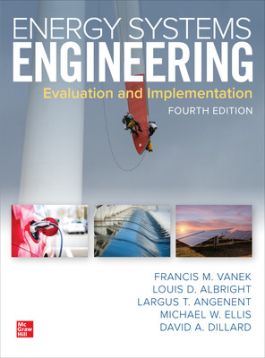Energy Systems Engineering: Evaluation and Implementation, Fourth Edition
Step 1. Download Adobe Digital Editions Both PC and Mac users will need to download Adobe Digital Editions to access their eBook. You can download Adobe Digital Editions at Adobe's website here.
Step 2. Register an Adobe ID if you do not already have one. (This step is optional, but allows you to open the file on multiple devices) Visit account.Adobe.com to register your Adobe account.
Step 3: Authorize Adobe Digital Editions using your Adobe ID. In Adobe Digital Editions, go to the Help menu. Choose “Authorize Computer.”
Step 4: Open your file with Adobe Digital Editions. Once you’ve linked your Adobe Digital Editions with your Adobe ID, you should be able to access your eBook on any device which supports Adobe Digital Editions and is authorized with your ID. If your eBook does not open in Adobe Digital Editions upon download, please contact customer service
Preface to the Fourth Edition
Acknowledgments
Note to Instructors
1. Introduction
1-1. Overview
1-2. Introduction
1-3. Relationship between Energy, Population, and Wealth
1-4. Pressures Facing World due to Energy Consumption
1-5. Energy Issues and the Contents of This Book
1-6. Units of Measure Used in Energy Systems
1-7. Summary
References
Further Reading
Exercises
2. Engineering Economic Tools
2-1. Overview
2-2. Introduction
2-3. Economic Analysis of Energy Projects and Systems
2-4. Direct versus External Costs and Benefits
2-5. Intervention in Energy Investments to Achieve Social Aims
2-6. NPV Case Study Example
2-7. Summary
References
Further Reading
Exercises
3. Climate Change and Climate Modeling
3-1. Overview
3-2. Introduction
3-3. Modeling Climate and Climate Change
3-4. Climate in the Future
3-5. Summary
References
Further Reading
Exercises
4. Fossil Fuel Resources
4-1. Overview
4-2. Introduction
4-3. Decline of Conventional Fossil Fuels and a Possible Transition to Nonconventional Alternatives
4-4. Summary
References
Further Reading
Exercises
5. Stationary Combustion Systems
5-1. Overview
5-2. Introduction
5-3. Fundamentals of Combustion Cycle Calculation
5-4. Advanced Combustion Cycles for Maximum Efficiency
5-5. Economic Analysis of Stationary Combustion Systems
5-6. Incorporating Environmental Considerations into Combustion Project Cost Analysis
5-7. Reducing CO2 by Capturing Emissions
5-8. Systems Issues in Combustion in the Future
5-9. Representative Levelized Cost Calculation for Electricity from Natural Gas
5-10. Summary
References
Further Reading
Exercises
6. Energy Conservation
6-1. Overview
6-2. Role of Conservation in Energy Sustainability
6-3. Understanding Energy Efficiency
6-4. Energy Conservation in Buildings
6-5. Energy Conservation through Appliance Selection and Operation
6-6. Energy Conservation in Industry
6-7. Energy Conservation in Agriculture, Water, and Food Production
6-8. Conclusion
References
Further Reading
Exercises
7. Carbon Sequestration
7-1. Overview
7-2. Introduction
7-3. Indirect Sequestration
7-4. Geological Storage of CO2
7-5. Sequestration through Conversion of CO2 into Inert Materials
7-6. Direct Removal of CO2 from Atmosphere for Sequestration
7-7. Overall Comparison of Sequestration Options
7-8. Summary
References
Further Reading
Exercises
8. Nuclear Energy Systems
8-1. Overview
8-2. Introduction
8-3. Nuclear Reactions and Nuclear Resources
8-4. Reactor Designs: Mature Technologies and Emerging Alternatives
8-5. Nuclear Fusion
8-6. Nuclear Energy and Society: Environmental, Political, and Security Issues
8-7. Representative Levelized Cost Calculation for Electricity from Nuclear Fission
8-8. Summary
References
Further Reading
Exercises
9. The Solar Resource
9-1. Overview
9-2. Introduction
9-3. Definition of Solar Geometric Terms and Calculation of Sun’s Position by Time of Day
9-4. Effect of Diffusion on Solar Performance
9-5. Summary
References
Further Reading
Exercises
10. Solar Photovoltaic Technologies
10-1. Overview
10-2. Introduction
10-3. Fundamentals of PV Cell Performance
10-4. Design and Operation of Practical PV Systems
10-5. Li
A definitive guide to energy systems engineering?thoroughly updated for the latest technologies
Fully revised for the latest technologies and data, this hands-on guide clearly explains the design, evaluation, and environmental impact of both conventional and sustainable energy systems. You will get comprehensive coverage of all types of energy systems, from fossil fuels and nuclear energy to solar, wind, and biofuels. Energy Systems Engineering: Evaluation and Implementation, Fourth Edition lays out each technology and discusses applications, benefits, and liabilities. This edition contains brand-new chapters that cover energy conservation, small-scale hydropower, geothermal, and heat pump systems, among other subjects.
Coverage includes:
- Engineering economic tools
- Climate change and climate modeling
- Fossil fuel resources
- Stationary combustion systems
- Energy conservation
- Carbon sequestration
- Nuclear energy systems
- Solar energy
- Solar photovoltaic technologies
- Active and passive solar thermal applications
- Wind energy systems
- Bioenergy resources and systems
- Transportation energy technologies, including electric vehicles
- Systems perspective on transportation energy
- Emerging technologies and systems
- Creating the twenty-first-century energy system

